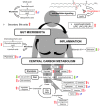Insulin resistance in prepubertal obese children correlates with sex-dependent early onset metabolomic alterations
- PMID: 27163744
- PMCID: PMC5056960
- DOI: 10.1038/ijo.2016.92
Insulin resistance in prepubertal obese children correlates with sex-dependent early onset metabolomic alterations
Abstract
Background: Insulin resistance (IR) is usually the first metabolic alteration diagnosed in obese children and the key risk factor for development of comorbidities. The factors determining whether or not IR develops as a result of excess body mass index (BMI) are still not completely understood.
Objectives: This study aimed to elucidate the mechanisms underpinning the predisposition toward hyperinsulinemia-related complications in obese children by using a metabolomic strategy that allows a profound interpretation of metabolic profiles potentially affected by IR.
Methods: Serum from 60 prepubertal obese children (30 girls/30 boys, 50% IR and 50% non-IR in each group, but with similar BMIs) were analyzed by using liquid chromatography-mass spectrometry, gas chromatography-mass spectrometry and capillary electrophoresis-mass spectrometry following an untargeted metabolomics approach. Validation was then performed on a group of 100 additional children with the same characteristics.
Results: When obese children with and without IR were compared, 47 metabolites out of 818 compounds (P<0.05) obtained after data pre-processing were found to be significantly different. Bile acids exhibit the greatest changes (that is, approximately a 90% increase in IR). The majority of metabolites differing between groups were lysophospholipids (15) and amino acids (17), indicating inflammation and central carbon metabolism as the most altered processes in impaired insulin signaling. Multivariate analysis (OPLS-DA models) showed subtle differences between groups that were magnified when females were analyzed alone.
Conclusions: Inflammation and central carbon metabolism, together with the contribution of the gut microbiota, are the most altered processes in obese children with impaired insulin signaling in a sex-specific fashion despite their prepubertal status.
Figures


Similar articles
-
Metabolomics allows the discrimination of the pathophysiological relevance of hyperinsulinism in obese prepubertal children.Int J Obes (Lond). 2017 Oct;41(10):1473-1480. doi: 10.1038/ijo.2017.137. Epub 2017 Jun 7. Int J Obes (Lond). 2017. PMID: 28588306
-
Progression from impaired glucose tolerance to type 2 diabetes in obese children and adolescents: a 3-6-year cohort study in southern Thailand.J Pediatr Endocrinol Metab. 2016 Nov 1;29(11):1267-1275. doi: 10.1515/jpem-2016-0195. J Pediatr Endocrinol Metab. 2016. PMID: 27740930
-
Metabolomics analysis reveals altered metabolites in lean compared with obese adolescents and additional metabolic shifts associated with hyperinsulinaemia and insulin resistance in obese adolescents: a cross-sectional study.Metabolomics. 2021 Jan 12;17(1):11. doi: 10.1007/s11306-020-01759-y. Metabolomics. 2021. PMID: 33438144 Free PMC article.
-
Insulin Resistance in Obese Children: What Can Metabolomics and Adipokine Modelling Contribute?Nutrients. 2020 Oct 29;12(11):3310. doi: 10.3390/nu12113310. Nutrients. 2020. PMID: 33137934 Free PMC article. Review.
-
Update on the cardiometabolic syndrome.Clin Cornerstone. 2001;4(2):17-23. doi: 10.1016/s1098-3597(01)90026-2. Clin Cornerstone. 2001. PMID: 11838324 Review.
Cited by
-
Consensus Clustering of temporal profiles for the identification of metabolic markers of pre-diabetes in childhood (EarlyBird 73).Sci Rep. 2018 Jan 23;8(1):1393. doi: 10.1038/s41598-017-19059-2. Sci Rep. 2018. PMID: 29362412 Free PMC article.
-
Probing erythrocytes as sensitive and reliable sensors of metabolic disturbances in the crosstalk between childhood obesity and insulin resistance: findings from an observational study, in vivo challenge tests, and ex vivo incubation assays.Cardiovasc Diabetol. 2024 Sep 11;23(1):336. doi: 10.1186/s12933-024-02395-9. Cardiovasc Diabetol. 2024. PMID: 39261864 Free PMC article.
-
Prebiotics, Probiotics, and Synbiotics-A Research Hotspot for Pediatric Obesity.Microorganisms. 2023 Oct 28;11(11):2651. doi: 10.3390/microorganisms11112651. Microorganisms. 2023. PMID: 38004665 Free PMC article. Review.
-
Association of Healthy Eating Index-2015 and Dietary Approaches to Stop Hypertension Patterns with Insulin Resistance in Schoolchildren.Nutrients. 2022 Oct 11;14(20):4232. doi: 10.3390/nu14204232. Nutrients. 2022. PMID: 36296916 Free PMC article.
-
Molecular Gatekeeper Discovery: Workflow for Linking Multiple Exposure Biomarkers to Metabolomics.Environ Sci Technol. 2022 May 17;56(10):6162-6171. doi: 10.1021/acs.est.1c04039. Epub 2022 Feb 7. Environ Sci Technol. 2022. PMID: 35129943 Free PMC article.
References
-
- Bluher S, Schwarz P. Metabolically healthy obesity from childhood to adulthood-does weight status alone matter? Metabolism 2014; 63: 1084–1092. - PubMed
-
- Reaven GM. Banting lecture 1988. Role of insulin resistance in human disease. Diabetes 1988; 37: 1595–1607. - PubMed
-
- Borai A, Livingstone C, Ferns GA. The biochemical assessment of insulin resistance. Ann Clin Biochem 2007; 44: 324–342. - PubMed
-
- Martos-Moreno GA, Barrios V, Chowen JA, Argente J. Adipokines in childhood obesity. Vitam Horm 2013; 91: 107–142. - PubMed
-
- Martos-Moreno GA, Barrios V, Martinez G, Hawkins F, Argente J. Effect of weight loss on high-molecular weight adiponectin in obese children. Obesity (Silver Spring) United States 2010; 18: 2288–2294. - PubMed
Publication types
MeSH terms
Substances
LinkOut - more resources
Full Text Sources
Other Literature Sources
Medical

